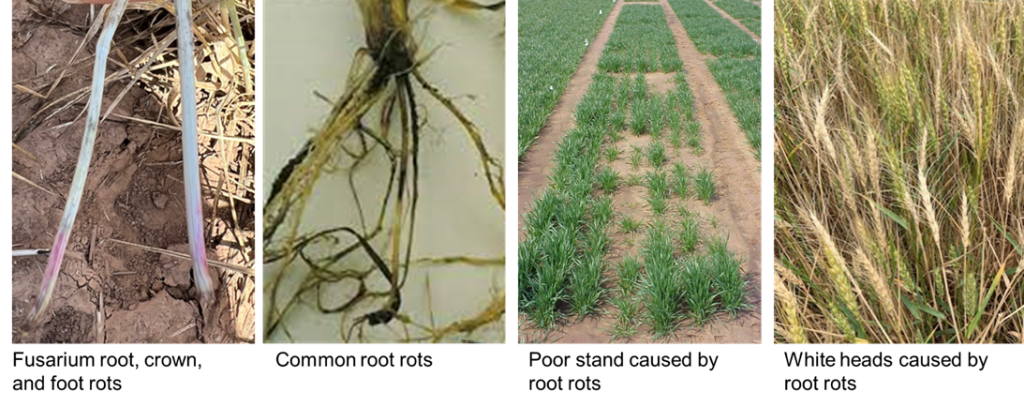Wheat Disease Update – October 5, 2022
Meriem Aoun, Small Grains Pathologist
Department of Entomology & Plant Pathology, Oklahoma State University.
As we start the new wheat season in Oklahoma, some disease management strategies can be made this fall to reduce damages later in the season. One of the most effective and sustainable ways to manage diseases is to grow resistant varieties. The use of disease resistant varieties in combination with cultural and chemical methods will help farmers reduce the impact of diseases. Early planted wheat is prone to infection by aphid-transmitted virus (i.e., barley yellow dwarf virus), and mite-transmitted viruses including wheat streak mosaic (WSM) virus, high plains virus, and Triticum mosaic virus. Last season (year 2021/2022), there was high incidence and severity of WSM (Figure 1) and barley yellow dwarf (BYD, Figure 2) in wheat fields in Oklahoma, thus delaying planting (after October 1 in northern Oklahoma, and after October 15 in southern Oklahoma) will limit these diseases. It is also critical to destroy volunteer wheat and grassy weeds to reduce the population of mites and aphids that transmits viruses to seedling wheat.
 Figure 1. Symptoms of wheat streak mosaic (WSM) in a farmer field in Grady County, OK (photo taken on April 13, 2022). Wheat curl mites that transmit WSM virus are shown in the picture on the right (photo credit: University of Kentucky).
Figure 1. Symptoms of wheat streak mosaic (WSM) in a farmer field in Grady County, OK (photo taken on April 13, 2022). Wheat curl mites that transmit WSM virus are shown in the picture on the right (photo credit: University of Kentucky).
 Figure 2. Symptoms of barley yellow dwarf (BYD) in a farmer field in Cleveland County, OK (photo taken on April 26, 2022). Aphids that transmit BYD virus are shown in the picture on the right.
Figure 2. Symptoms of barley yellow dwarf (BYD) in a farmer field in Cleveland County, OK (photo taken on April 26, 2022). Aphids that transmit BYD virus are shown in the picture on the right.
Seed treatment with a systemic insecticide that contains imidacloprid or thiamethoxam can also be used to control aphids that transmit BYD virus. Seed treatment insecticides are not effective in controlling the mites or the mite-transmitted viruses. Seed treatments using fungicides and later planting can reduce root rots such as common root rots and Fusarium root/crown/foot rots that were prevalent and severe last season in multiple wheat fields in Oklahoma (Figure 3). Seed treatment may not necessarily affect root rots in spring, but generally results in increased yield. With the lack of varieties with acceptable levels of resistance to root rots, managing root rots is difficult.
 Figure 3. Symptoms of Fusarium root/crown/foot rots and common root rots. Root rots result in poor stand and white heads.
Figure 3. Symptoms of Fusarium root/crown/foot rots and common root rots. Root rots result in poor stand and white heads.
Seed treatments using fungicides are also effective to control bunts and smuts, including common bunt (also called stinking smut because of its ‘fishy’ odor) and loose smut. Common bunt and loose smut were observed last season in wheat fields in Oklahoma (Figure 4). If either common bunt or loose smut was observed in a field last season, grain harvested from such field should not be used as seed this year. In this case, it is strongly recommended to use certified seed. However, if grain harvested from such contaminated fields must be used as seed, seed treatment at a high rate should be applied. Seed treatment using fungicides can also help control fall foliar diseases such as leaf rust, stripe rust, tan spot, spot blotch, leaf and glume blotch, and powdery mildew.
 Figure 4. Common bunt/stinking smut (photo on the left) and loose smut (photo on the right).
Figure 4. Common bunt/stinking smut (photo on the left) and loose smut (photo on the right).